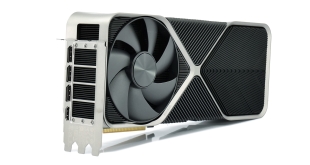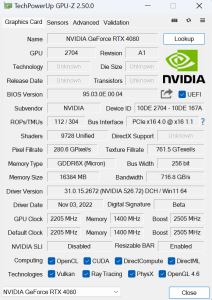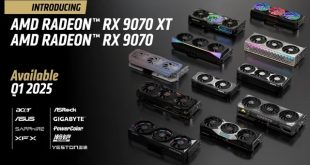
Today's launch would have marked the release of the first of two RTX 4080 SKUs… but as we know, the RTX 4080 12GB was summarily ‘unlaunched' just weeks after its initial announcement. The RTX 4080 16GB now stands alone as the sole xx80 SKU for the 40-series, priced at £1269 here in the UK. The sheer cost has risen many an eyebrow, but can this graphics card bring enough to the table to justify its position in the market? We put it through its paces today and find out.
Announced alongside the RTX 4090 at GTC in September, the Nvidia RTX 4080 marks a change in strategy for the xx80 SKU. Unlike the RTX 3080 and RTX 3090, which were both built on the top-tier GA102 die, this time around the RTX 4080 does not share the same core silicon as the RTX 4090. We know RTX 4090 is built on AD102, but Nvidia has introduced a new die for the RTX 4080 – AD103.
This means there is a much larger separate between the xx80 and xx90 products than what we saw last generation. The RTX 3080 offered just 17% fewer cores than the RTX 3090, but the RTX 4080 is cut down by more than a third. As we shall see, that manifests itself as a signifiant performance differential between the two 40-series cards.
Still, we have plenty of benchmarks to go over before giving our final verdict. If you want to read this review as a single page, click HERE.
| RTX 4090 | RTX 4080 | RTX 3090 Ti | RTX 3090 | RTX 3080 Ti | RTX 3080 | |
| Process | TSMC N4 | TSMC N4 | Samsung 8N | Samsung 8N | Samsung 8N | Samsung 8N |
| SMs | 128 | 76 | 84 | 82 | 80 | 68 |
| CUDA Cores | 16384 | 9728 | 10752 | 10496 | 10240 | 8704 |
| Tensor Cores | 512 | 304 | 336 | 328 | 320 | 272 |
| RT Cores | 128 | 76 | 84 | 82 | 80 | 68 |
| Texture Units | 512 | 304 | 336 | 328 | 320 | 272 |
| ROPs | 176 | 112 | 112 | 112 | 112 | 96 |
| GPU Boost Clock | 2520 MHz | 2505 MHz | 1860 MHz | 1695 MHz | 1665 MHz | 1710 MHz |
| Memory Data Rate | 21 Gbps | 22.4 Gbps | 21 Gbps | 19.5 Gbps | 19 Gbps | 19 Gbps |
| L2 Cache | 73729 KB | 65536 KB | 6144 KB | 6144 KB | 6144 KB | 5120 KB |
| Total Video Memory | 24GB GDDR6X | 16GB GDDR6X | 24GB GDDR6X | 24GB GDDR6X | 12GB GDDR6X | 10GB GDDR6X |
| Memory Interface | 384-bit | 256-bit | 384-bit | 384-bit | 384-bit | 320-bit |
| Memory Bandwidth | 1008 GB/Sec | 716.8 GB/Sec | 1008 GB/Sec | 936 GB/Sec | 912 GB/Sec | 760 GB/Sec |
| TGP | 450W | 320W | 450W | 350W | 350W | 320W |
First, for a quick spec recap. We already mentioned that RTX 4080 uses the AD103 die, and this is notably smaller than AD102, measuring 378.6mm2. Accordingly, transistor count is reduced from 76.3 billion, down to 45.9 billion. The fundamental building blocks are still the same of course, with the RTX 4080 offering a total of 84 Streaming Multiprocessors (SMs), each housing 256 CUDA Cores, for a total of 9728. We also find 84 RT cores, 336 Tensor cores, 336 Texture Units, and 112 ROPs.
TSMC's N4 node has Nvidia cranking up the clock speed significantly this generation, with the RTX 4080 sporting a 2505MHz rated boost clock. That's nominally 15MHz slower than the RTX 4090, but we'd expect overall behaviour to be very similar.
The memory configuration is another area where AD103 has been cut-back significantly. The memory interface has been reduced to 256-bit, and even with 16GB GDDR6X running at 22.4Gbps, that cuts memory bandwidth down to 716.6GB/s. That said, there has been a substantial upgrade to the L2 cache with the Ada architecture, with the RTX 4080 now offering 65.5MB, compared to just 6MB for GA102.
Considering RTX 4080 is notably cut-down versus the RTX 4090, rated power draw is lower, with a 320W TGP. This is something we focus on closely, using our updated GPU power testing methodology in this review, so read on for our most detailed power and efficiency testing yet.
 KitGuru KitGuru.net – Tech News | Hardware News | Hardware Reviews | IOS | Mobile | Gaming | Graphics Cards
KitGuru KitGuru.net – Tech News | Hardware News | Hardware Reviews | IOS | Mobile | Gaming | Graphics Cards



